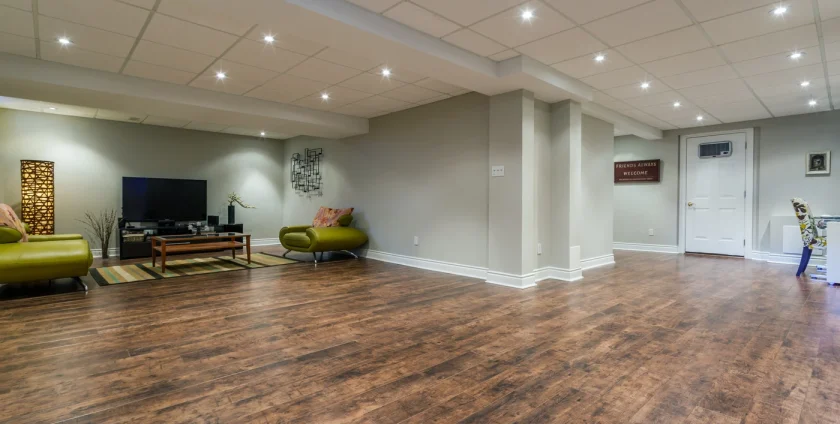
Hardwood flooring adds warmth and elegance to any home, which is why so many homeowners opt for a hardwood floor installation when renovating their home. When it comes to hardwood flooring Chicago, not every environment or property is suitable for this type of material. For instance, when you are looking to renovate your basement, you may want to look at flooring alternatives.
Basements are the lowest part of the property and have concrete slabs as their foundation. This means that the maintenance requirements of the basement may differ somewhat from other areas of the home. Basements generally experience more moisture or water damage, which is why it is important to choose a flooring material that is not affected by moisture.
The benefit of building a new home is that you are in control and can make double sure that the basement floor is properly installed. This includes incorporating a floor design that will prevent moisture buildup, making it suitable for any type of flooring installation. A basement requires a well-laid foundation with a vapor barrier, which adds to the energy efficiency of your home. Either an interior or an exterior drainage system is required to reduce water seepage. Furthermore, it’s important to confirm that the foundation has proper grading and an effective sump pump to reduce water damage.
How to Prepare Your Basement
When designing your home, there are some measures you can take to make sure your basement will provide a suitable environment for your choice of flooring. For better groundwater drainage, the concrete slab must be in good shape and, most of the time, have a layer of porous fill in the aggregate bed. Any groundwater should automatically be redirected away from the property or towards the sump pump basin.
Often homeowners install a radiant heating system underneath the concrete slab to better control the concrete’s natural tendency to cool. If this is the case with your basement design, you will need to install a system of flexible tubing before the contractors start pouring the concrete slab.
A freshly poured concrete slab needs at least 30 days to cure. Only thereafter can a sub-floor be installed. It’s best to install a vapor barrier when installing the sub-flooring as this will help to prevent water damage to any flooring you choose to install. This will form an effective barrier to block any moisture rising from the ground to reach the sub-flooring.
A vapor barrier is of great importance during the time that the concrete is drying but remains important even after the concrete has dried and settled. Moisture can rise from the ground which can cause damage to the concrete and of course continue its destructive path up to the flooring level.
Vapor barriers are available in a variety of materials like PVC, polyethylene sheets or 15-pound roofing felt. The vapor barrier should be covered with a layer of insulation to stop heat escaping through surfaces like the outer walls. The insulation layer should be between one and two inches thick. The thickness is dependent on your local weather conditions, where colder climates require thicker insulation layers.
The latest in vapor barrier material is Polyethylene, which is the preferred material. It can endure heavy loads and is able to resist mold, mildew and fungus. This is an ideal vapor barrier type to use and will be suitable for a variety of flooring options, for instance cork flooring, bamboo flooring, engineered hardwood flooring, linoleum, carpeting or a laminate floor installation. When it comes to using the right type of adhesive, it’s always best to check the manufacturer’s recommendations.
How to Choose the Best Flooring for Your Basement
Choosing the best and most suitable flooring is essential whether you are renovating an old basement or building a new house. In general, it is not advisable to have a hardwood floor installation done in a basement. This is mainly due to basements being more susceptible to excess moisture, which can result in cupping, swelling, warping, and splitting of the wood. Ground seepage can result in gradual damage to any flooring type that worsens over time. However, a burst pipe or broken water heater will wreak havoc on hardwood flooring.
If you are set on installing a floor in your basement that resembles natural wood, there are a few suitable solutions that you can consider. We have compiled a list of flooring options that resemble wood, but that are not as vulnerable to moisture damage.
Laminate Flooring
A laminate floor installation is a great alternative to hardwood flooring in your basement. The major advantage of laminate is that it is much more water resistant compared to solid wood. Laminate at its core is made of high-density fiber and the photographic HDF forms the top layer that depicts actual wood.
Homeowners have a variety of design possibilities as the top layer of laminate is versatile and can be produced to resemble various wood textures, vinyl patterns or tile patterns. A laminate floor installation can be done in one of four ways, which are floating, tongue-in-groove, interlocking or locking methods. This provides stability and takes the radiant in-floor heating into account.
Engineered Hardwood Flooring
A more recent option available on the market, engineered hardwood makes it simpler to have a natural wood design flooring in a moisture rich environment, like the basement. Engineered hardwood is manufactured from a combined core of plywood, hardwood, or HDF and finished with a hardwood veneer top layer.
Unlike the photographic final layer of laminate, the engineered hardwood flooring is finished with an actual layer of hardwood, giving it a more authentic look. It is available in many varieties of wood types, allowing you to choose the flooring that best matches your design vision. For enhanced stability, it is typically made up of three or more core layers fused together using a high-pressure bonding method.
The multiple ply planking and bonding method offers a great barrier of protection against radiant heating systems and prevents any warping, splitting, or cupping brought on by water. The thickness of the hardwood veneer can differ, but most flooring professionals advise to choose a veneer thickness of at least 2mm.
Depending on the type of wood used, what type of design you prefer and of course your budget, the veneer’s thickness can differ. Using the Janka Hardness Scale, you can choose the best type of wood, most suitable to your unique requirements and budget. In general, harder types of wood are more durable. If your basement is expected to be a high-traffic area, rather pick a harder wood type.
Solid Hardwood Flooring
Solid hardwood flooring is made from solid wood planks and has natural wood throughout its core. A hardwood floor installation is usually done with the tongue-and-groove method, followed by a thorough sanding down process to create a smooth surface. This type of flooring costs more than for instance a laminate floor installation or engineered hardwood flooring. A natural wood floor is especially vulnerable to water damage and other elements.
Should a solid hardwood floor sustain extensive water damage the only solution is usually to replace the entire floor. This can be a costly exercise. Solid hardwood flooring is also more prone to sustain damage from radiant heating systems, which are often installed in basements.
The Installation of a Basement Floor
Most basements have a concrete slab as its floor foundation. This means that a conventional hardwood floor installation technique (with hammer and nails) is out of the question. The flooring can either be glued in place or installed utilizing the floating method. Gluing is not advisable if a radiant heating system is installed, since the heat generated by the tubing system may interfere with the adhesives.
Make use of the heating and cooling systems available when installing any kind of wood flooring in a basement where moisture damage may be a problem. The air conditioner can help to reduce humidity and the heating device can aid in drying out the concrete slab.
In Conclusion
Basements tend to be moisture prone, which does not make it an ideal environment for a hardwood floor installation. Good news is that there are several alternative wood resembling flooring options available, like laminate flooring and engineered hardwood flooring.
Check the state of the concrete slab carefully to make sure there are no breaks or cracks before installing any type of new basement flooring. If there is damage, it is imperative that you fix it before installing any new flooring.
To reduce potential damage from water or other elements, make sure to research your options and adhere to all installation instructions.
A flooring contractor will give you the best flooring advice and expert guidance whether you are renovating an existing basement or building a new home. Make the right choice to be able to enjoy the warmth and beauty of wood without running the danger of significant damage, repair, or replacement costs.
Let PETER Hardwood Flooring assist you with choosing the right flooring for your property. Our friendly teams will provide you with expert advice. You can rely on the knowledge and experience of PETER Harwood Flooring. Contact us today.
- By: admin
- Category: Uncategorized
- 0 comment






